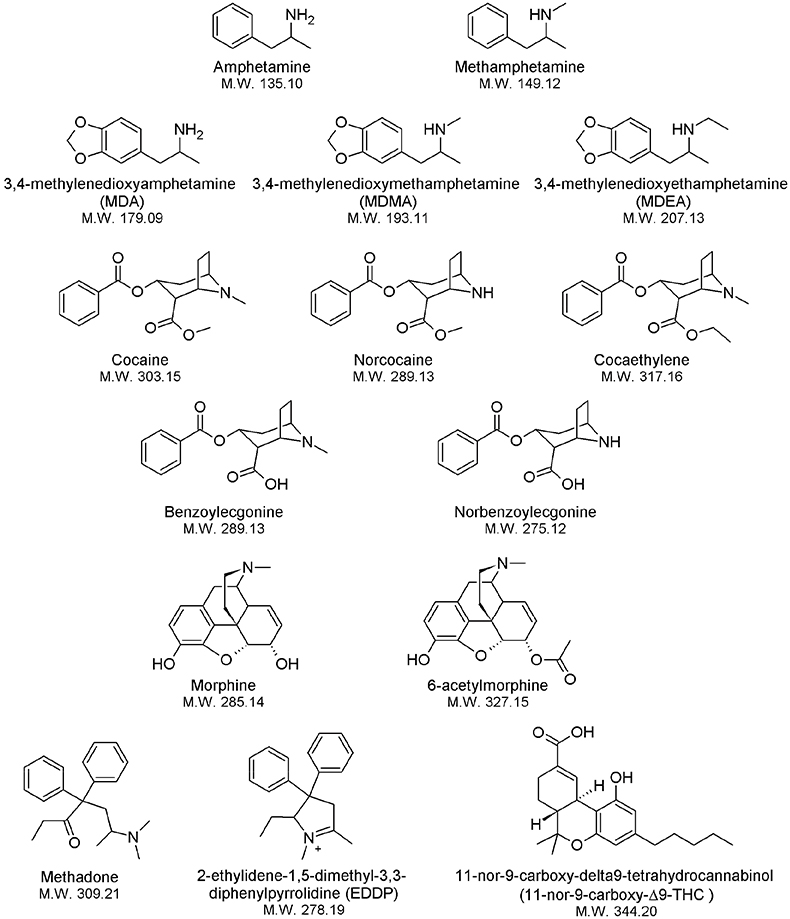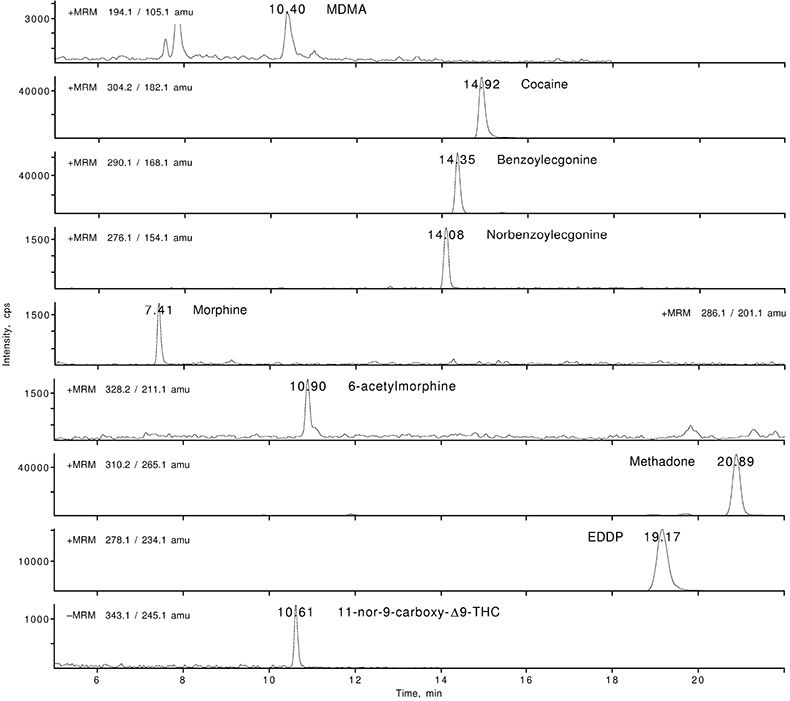Sara Castiglioni,* Ettore Zuccato, Chiara Chiabrando, Roberto Fanelli and Renzo Bagnati
Department of Environmental Health Sciences, Mario Negri Institute for Pharmacological Research, via La Masa 19, 20156 Milan, Italy. E-mail: [email protected]
Introduction
In recent years, the environmental fate of therapeutic drugs used by humans and animals (environmental pharmacology) has increasingly become recognised worldwide as an emerging issue.1 After administration, drugs can be excreted in high percentages as the parent compound and/or active metabolites in urine and faeces and reach wastewater treatment plants (WWTPs) and then be released into surface waters, soil and sediments. Concentrations of therapeutic drugs and their metabolites in waste and surface water are measured by highly selective and sensitive mass spectrometric techniques, such as gas chromatography-mass spectrometry (GC-MS) or high performance liquid chromatography-tandem mass spectrometry (HPLC-MS/MS). Using data obtained in this way, information about human metabolism of single active principles, and WWTPs characteristics (e.g., flow rate, population served), it is possible to calculate the environmental loads of therapeutic drugs2 and correlate them to their effective use (known from sales or production data).
Recently, this approach was used to study the environmental diffusion of illicit drugs and to estimate their effective use. The global production of major illicit drugs is comparable to that of widely used pharmaceuticals, and similar concentrations and behaviour are expected in WWTPs and in the environment. An initial study on cocaine3 showed that it was possible, from measurements of the main metabolite, benzoylecgonine, to estimate the number of doses that were used by the population served by a particular treatment plant. Other illicit drugs and related substances (amphetamines, morphine, heroin, cannabinoids, methadone) are now under investigation,4 and this method could be applied to integrate information obtained by conventional approaches, such as population surveys, consumer interviews and crime statistics.
We will consider here the analytical aspects involved in the measurements of illicit drugs and their metabolites in wastewater samples by HPLC-MS/MS.
HPLC-MS/MS analysis
A specific method for the determination of cocaine, amphetamines, morphine and derivatives, the main metabolite of tetrahydrocannabinol (THC-COOH), methadone and/or some of their metabolites in wastewater was developed by using solid phase extraction (SPE) and HPLC-MS/MS. The investigated compounds (Figure 1) are mostly small molecules with masses ranging from 135 amu to 344 amu. For each substance, the corresponding deuterated analogue was also analysed. Two main factors, matrix effect and sensitivity, were carefully considered to optimise the analytical conditions in wastewater. The use of deuterated internal standards (IS) was helpful for minimising the matrix effects that can affect electrospray sources and, at the same time, chromatographic conditions were optimised to reduce the background noise at low masses. This resulted in a sensitivity in the low pg/injected range for the external standards, and in the low ng L–1 range for samples extracted from a complex matrix such as wastewater.

Figure 1. Structures and molecular weights of the investigated illicit drugs and metabolites.
For wastewater analysis, samples were collected from the influent (untreated) and effluent (treated) wastewater of a treatment plant. Samples (1–2 L each) were filtered, and 50 mL aliquots were spiked with 20 ng of each IS, adjusted to pH 2.0 with 37% HCl and extracted using mixed reversed-phase cation-exchange cartridges (Oasis-MCX-Waters Corp., Milford, MA, USA). The cartridges were conditioned as suggested by the manufacturer and eluted with 3 mL of methanol and 3 mL of a 2% ammonia solution in methanol. The eluates were dried under a nitrogen stream, redissolved in 200 µL of MilliQ water, centrifuged and transferred into glass vials for instrumental analysis.
Drugs were analysed using an XTerra MS C18, 100 × 2.1 mm, 3.5 µm column (Waters Corp., Milford, MA, USA), at a flow rate of 200 µL min–1. Substances to be analysed were divided into four groups to optimise chromatographic separation and sensitivity for each component. The positive ion mode was used for most residues, and the negative ion mode for the main metabolite of tetrahydrocannabinol, 11-nor-9-carboxy-Δ9-THC and 11-nor-9-carboxy-Δ9-THC-D3. Acetic acid (0.05% in water) and triethylamine (0.05% in water), mixed with acetonitrile, were used as eluents, respectively, in the positive- and negative-ion mode. The chromatographic conditions were optimised according to the characteristics of each group of substances.
The mass spectrometer system was an API 3000 triple quadrupole mass spectrometer, equipped with a turbo ion spray source (Applied Biosystems–Sciex, Thornhill, Ontario, Canada). Mass spectrometric analyses were performed by selected reaction monitoring (SRM) mode, using the two most abundant precursor/product ion transitions for each substance. Mass parameters for each compound were reported in detail elsewhere.4 Typical SRM chromatograms, obtained from the analysis of a wastewater sample are shown in Figure 2.

Figure 2. HPLC-SRM chromatograms of the most abundant illicit drugs and their metabolites in wastewater.
Quantitation was made by isotope dilution, using the deuterated analogue as internal standard for each drug residue. Six-point calibration curves were used for linear regressions and the coefficients were higher than 0.999 for all the compounds.
The recoveries and the repeatability of the analytical method were tested by analysing influent and effluent samples (50 mL) in triplicate, spiking samples with different amounts of the investigated substances. The detection limits (LOD) and quantification limits (LOQ) for the whole method were calculated on the same samples. LOD was based on a signal-to-noise (S/N) ratio of 3 and LOQ on a S/N ratio of 10. Recoveries in WWTP influents and effluents were generally greater than 80%. Standard deviations were 10% or lower in influents and generally 5% or lower in effluents. LOQs for influents and effluents were in the low ng L–1 range.4
The method was used to analyse several wastewater samples collected in Italy and Switzerland. The most abundant compounds were cocaine and its main metabolite benzoylecgonine, with concentrations ranging from 0.2 µg L–1 to 1 µg L–1. Concentrations of other metabolites of cocaine (norcocaine, norbenzoylecgonine, cocaethylene) were substantially lower (4–36.6 ng L–1). Morphine, which may derive from illicit use of heroin, but also from clinical use of morphine or codeine, was detected in concentrations ranging from 80 ng L–1 to 200 ng L–1, and 6-acetylmorphine, which is a specific metabolite of heroin, in concentration of 5–10 ng L–1. The main metabolite of tetrahydrocannabinol, 11-nor-9-carboxy-Δ9-THC, was in the 60–90 ng L–1 range, and methadone and its main metabolite 2-ethylidene-1,5-dimethyl-3,3-diphenylpyrrolidine (EDDP) in the 10–90 ng L–1 range. Amphetamines were found in concentrations lower than 20 ng L–1, the most abundant being 3,4-methylenedioxymethamphetamine [MDMA(”Ecstasy”)]. Concentrations of drugs and metabolites were generally lower in effluents than in influents, depending on the WWTP removal efficiency. Significant amounts of illicit drugs and metabolites were still present in the effluents, and are therefore discharged in the aquatic environment of populated areas.
In conclusion, HPLC-MS/MS was found to be a highly sensitive and selective method for detecting illict drugs and/or metabolites in wastewater. The method allowed determinations in the low ng L–1 range, with an overall variability lower than 10%. The presence of these substances in WWTPs was verified, and each compound was quantified in both the influents and effluents. Illicit drugs can now be regarded as ubiquitous environmental contaminants, as previously proven for pharmaceuticals.2 Moreover, the concentrations of illicit drugs in WWTP influents may reflect consumption of illicit drugs by the local population, and could be useful for estimating and monitoring drug abuse and consumption patterns in a community in real time.
References
- T. Heberer, Toxicol. Lett. 131, 5–7 (2002). https://doi.org/10.1016/S0378-4274(02)00041-3
- S. Castiglioni, R. Bagnati, R. Fanelli, F. Pomati, D. Calamari and E. Zuccato, Environ. Sci. Technol. 40, 357–363 (2006). https://doi.org/10.1021/es050991m
- E. Zuccato, C. Chiabrando, S. Castiglioni, D. Calamari, R. Bagnati, S. Schiarea and R. Fanelli, Environ. Health 4, 14 (2005). https://doi.org/10.1186/1476-069X-4-14
- S. Castiglioni, E. Zuccato, E. Crisci, C. Chiabrando, R. Fanelli and R. Bagnati, Anal. Chem. 78, 8421–8429 (2006). https://doi.org/10.1021/ac061095b

